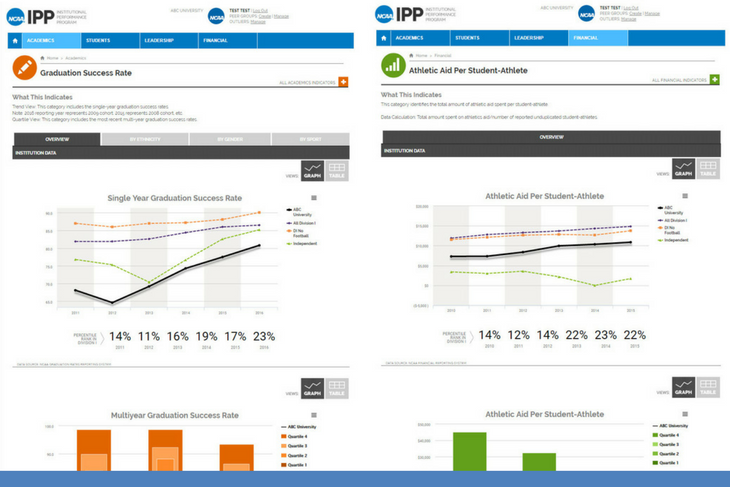NCAA develops game-changing enterprise software system
You’re familiar with the NCAA. National Collegiate Athletic Association tournaments in multiple sports are some of the most-watched television events every year, particularly the Men’s Final Four basketball championship in the spring. You may have even visited the Hall of Champions museum at White River State Park in Indianapolis next door to the NCAA national headquarters, which relocated to the city in 1999.
Lesser known are the technological achievements of the NCAA. Beginning in 2014, at the same time that they were migrating the entire organization to the cloud, they also launched one of the most ambitious data management and software development projects the organization had ever conceived. The resulting Institution Performance Program, or IPP for short, is a game-changer for intercollegiate athletics.
“People may be familiar with just one segment of what we do at the NCAA — likely they know about our tournaments and the Final Four — and they might not know that our scope is so much larger as an association that supports almost 500,000 student athletes at 1,100 schools nationwide,” said Judd Williams, Chief Information Officer.“What our tech team here in Indianapolis has done in collaboration with our Academic and Membership Affairs department and the membership itself, is create an enterprise software system that’s easy to use and invaluable for strategic insights and strategic planning.”

Development of the Institution Performance Program landed the NCAA on InformationWeek’s annual “InformationWeek Elite 100,” a list of companies the magazine editors rank as America’s most innovative and imaginative users of business technology.
The Case for an Enterprise Software System
The IPP is a big idea that originally started as a white paper by Troy Arthur, director of academic and membership affairs.
“When President Emmert joined the NCAA in 2011, he really encouraged all of us to challenge the status quo,” Arthur said. “We questioned the virtue of our previous accreditation processes that were more bureaucratic with 200-page reports from each university and data spread across seven different systems.”Arthur’s white paper posited that the continuous improvement accreditation model common in engineering fields could be applied to intercollegiate athletics, making the data collection process more efficient and effective, and a single source of truth enterprise system would offer a level of access to data never-before seen in intercollegiate athletics.
Imagine a campus-wide census conducted by each of the NCAA’s 1,100 member universities and you’ll have a good start for understanding the scope of information included in the Institution Performance Program (IPP).
Fortunately, they didn’t have to start from scratch — the NCAA had about 20 years of existing data living within its different internal systems — but the challenge of bringing all of this vital information into an intuitive and secure enterprise system that their member universities would actually use was just as challenging for the tech team as it sounds.
During an 18-month discovery and planning period, NCAA personnel traveled across the country collecting feedback from constituents at all levels, which helped the development team zero in on those data sets and reports most desired by the membership. While the IPP launched initially with Division I data only in 2015, it was quickly scaled up to include Division II and Division III data in 2016.
Membership Uses IPP in Unexpected Ways
Personnel from university presidents and chancellors to athletic directors, and senior leadership like CFOs use the IPP platform to access information such as:
- Financial data (expenses and revenue and everything in between)
- Academic data (GPA, course load, etc.)
- Continuing education data (student athlete degree progress and post-graduate placement)
- Demographic data (race and gender for the entire student body and student athlete population).
Approximately 36 standardized reports are available with up to 15 subset reports for each of the aforementioned data categories. Users may also create reports based on their conference peers or on customized cohort groups they choose themselves.
For example, an athletic director may want to benchmark her own school’s student athlete recruitment spending, coaches salaries, or marketing and promotions budget against all other schools in the conference, or she may want to see data from only public institutions, only private institutions, or a customized combination of competitive universities.

Click here and here for larger views of the screenshots above.
Schools are using this one-stop-shop information source to drive their strategic or operational plans and to affect change at their institutions now as opposed to searching multiple databases and systems for previously available data that was years old at best or simply anecdotal. IPP has also proven to be an invaluable resource for reporting the most compelling data to trustees, university leadership and faculty.
The IPP Performance and Tech Stack
“Bringing IPP to life was a giant joint exercise marshalling resources from AMA (Academic and Membership Affairs, IT, and membership, including an IPP committee we formed with key university leaders,” CIO Williams said. “From the genesis to the product development and technical execution, IPP was built in Indianapolis at the NCAA and that’s something we’re very proud of, in addition to the exceptional feedback and high adoption rate.”
After just nine months of availability among Division I schools (350 sites), IPP had more than a 90% adoption rate with between one and 15 users per school. “That’s a remarkable adoption rate for a non-B2B enterprise system that’s completely voluntary,” said Williams. Member universities are not required to to use the system for compliance or regulatory purposes, so Williams attributes the high adoption rate to the usefulness of the platform and its user-friendly design.
The specific tech stack for NCAA’s Institution Performance Program (IPP) includes:
- Ruby on Rails (application writing)
- Oracle (database storage)
- User Interface
- AJAX
- Carousels
- jQuery Elements (for visual appeal)
- Yamm Megamenu (navigation)
- Bootstrap (device presentation)
- YAMM! Megamenu (navigation)
- Glyphicons
NCAA employs 514 people in Indianapolis including 35 full-time IT staff plus an on site third-party service desk and a handful of contractors.




